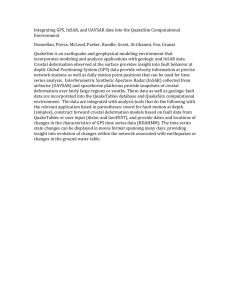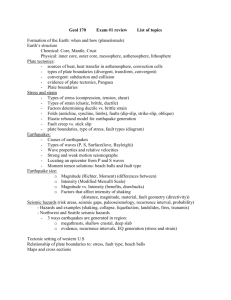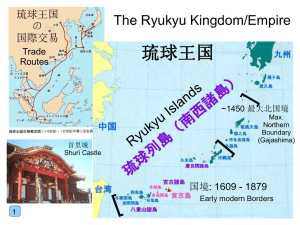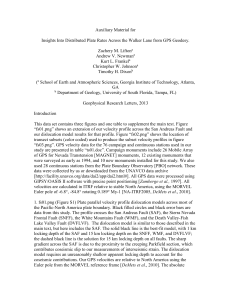grl29396-sup-0002-txts01
advertisement
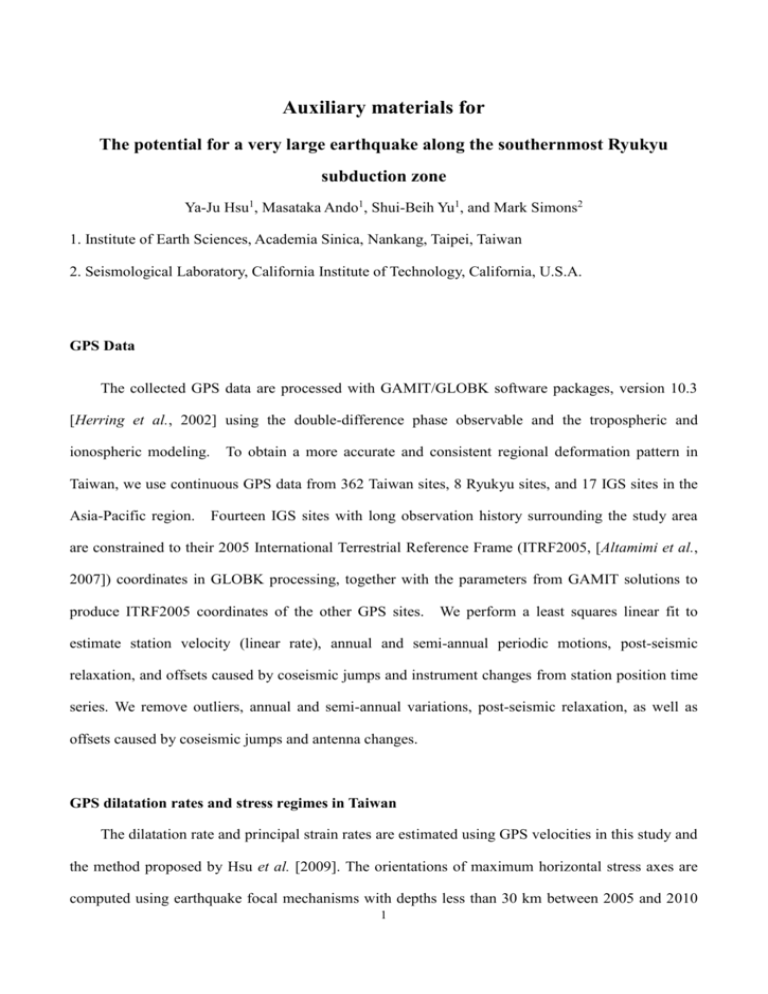
Auxiliary materials for The potential for a very large earthquake along the southernmost Ryukyu subduction zone Ya-Ju Hsu1, Masataka Ando1, Shui-Beih Yu1, and Mark Simons2 1. Institute of Earth Sciences, Academia Sinica, Nankang, Taipei, Taiwan 2. Seismological Laboratory, California Institute of Technology, California, U.S.A. GPS Data The collected GPS data are processed with GAMIT/GLOBK software packages, version 10.3 [Herring et al., 2002] using the double-difference phase observable and the tropospheric and ionospheric modeling. To obtain a more accurate and consistent regional deformation pattern in Taiwan, we use continuous GPS data from 362 Taiwan sites, 8 Ryukyu sites, and 17 IGS sites in the Asia-Pacific region. Fourteen IGS sites with long observation history surrounding the study area are constrained to their 2005 International Terrestrial Reference Frame (ITRF2005, [Altamimi et al., 2007]) coordinates in GLOBK processing, together with the parameters from GAMIT solutions to produce ITRF2005 coordinates of the other GPS sites. We perform a least squares linear fit to estimate station velocity (linear rate), annual and semi-annual periodic motions, post-seismic relaxation, and offsets caused by coseismic jumps and instrument changes from station position time series. We remove outliers, annual and semi-annual variations, post-seismic relaxation, as well as offsets caused by coseismic jumps and antenna changes. GPS dilatation rates and stress regimes in Taiwan The dilatation rate and principal strain rates are estimated using GPS velocities in this study and the method proposed by Hsu et al. [2009]. The orientations of maximum horizontal stress axes are computed using earthquake focal mechanisms with depths less than 30 km between 2005 and 2010 1 as well as the method proposed by Lund and Townend [2002]. The trends of maximum horizontal compressive axes correspond to the direction of the normal of the vertical plane experiencing maximum normal stress. (a) (b) Figure S1. (a) Dilatation and principal strain rates. The color scale indicates dilatation rates in μstrian/yr. Black vectors denote the two principal strain-rate axes. Major faults are indicated as green lines. The white dots denote GPS sites. (b) Black bars and texts show the orientations of maximum compressive horizontal stress axes derive from the earthquake focal mechanisms at the depth range less than 30 km between 2005 and 2010 (Wu et al., 2010). Gray bars indicate the 95% confidence regions of the maximum compressive horizontal stress axes. Major faults are indicated as black lines. LVF: Longitudinal Valley Fault. A backslip model simultaneously investigate strain accumulation effects on the LVF and the Ryukyu thrust 2 Here we address the trade-off of strain accumulation effects on the LVF and the Ryukyu megathrust. We construct a backslip model including the northern and southern portions of the LVF as well as the Ryukyu megathrust. The northern LVF (NLVF) and southern LVF (SLVF) consists of 25°- and 22°-trending segments with dip of 60° and 45°, respectively. Both NLVF and LVF extend from the surface to a depth of 25 km following the distribution of local seismicity. The Ryukyu fault (RyukyuT) is a 290°-trending segment with dip 10° to the north. The fault extends about 70 km from the Ryukyu Trench to a depth of 13 km. We fix aforementioned fault parameters and solve for slip-deficit rate and the long-term slip rate of each fault using a prioir constraints from previous studies (Hsu et al., 2003; Ching et al., 2011) and the plate convergence rate of 80~85 mm/yr between the EU and PSP. Figure S2 below shows the derived slip-deficit rate, inferred long-term slip rates of each fault, and residuals. The reduced-chi square of this model is 9.4. The slip deficit rate is 85 mm/yr on the shallow Ryukyu thrust if we take account both strain accumulation effects on the LVF and the Ryukyu megathrust. This value is similar to the inferred slip-deficit rate of 86 mm/yr considering only the strain accumulation effect on the Ryukyu megathrust in the main text. The accumulated strain north of latitude 23.5°N seems to be better explained by fault coupling on the Ryukyu megathrust. 3 (a) (b) Figure S2. (a) Fault slip-deficit rate (color scale) and inferred long-term slip rates (magenta vectors) on the northern (NLVF) and southern (SLVF) portions of the LVF and the Ryukyu thrust fault (RyukyuT). Black and blue vectors indicate observed and predicated GPS velocities. (b) Horizontal residuals (difference between black and blue vectors in (a)). Gird search We use a grid search to find the optimal fault parameters, which give the minimum misfit. We vary the rate and the orientation of block motion from 80 to 90 mm/yr and 290° to 320°, respectively, according to the plate convergence rate of 80-85 mm/yr in the direction of 300°~310° between the EU and the PSP [Seno et al., 1993; Yu et al., 1997; Sella et al., 2002; Hsu et al., 2009]. We also vary fault dip from 5° to 15°, fault width from 30 to 80 km and location of the fault. The fit to the data is quantified from the mean of the normalized square residuals, r2 . on average the model fits the data within uncertainties. 4 A r2 value of 1 indicates that Fault models with variable plate coupling ratios To explore the impact of a non-uniform slip-deficit rate perpendicular to the Ryukyu Trench, we consider a forward model where we parameterize plate coupling as a Gaussian function along the down-dip direction of the fault. We then predict surface velocities at each model and compare with GPS observations. If the shallow Ryukyu subduction zone is fully locked, the slip-deficit rate equals to the long-term plate motion such that the plate coupling ratio, defined as the ratio between the slip-deficit rate and the plate convergence rate, is equivalent to 1. Figure S3 shows the values of r2 from fault models with plate coupling ratios vary as a Gaussian function, c exp (d 2 / D 2 ) , where c is the coupling ratio, d is the distance, and D is the distance-decay constant controlling the spatial variation of the coupling ratio. We consider two scenarios, one where c varies from 1 at trench axis to 0 below Suao (Figure S3(a)) and the complementary model whereby c varies from 0 at trench axis to 1 below Suao (Figure S3(b)). We search for a wide range of D and find the fault model with a large plate coupling ratio gives the smallest misfit. The smallest values of r2 are 12.5 in these two models, comparable to that in a uniform slip model. We find these two forward models require plate interface to be fully coupled from the trench to a depth of 13 km. (a) 5 (b) Figure S3. Plate coupling models with coupling ratios vary as a Gaussian function. (a) The coupling ratio varies from 1 at trench axis to 0 at the bottom of the fault; (b) from 0 at trench axis to 1 at the bottom of the fault. The color lines in left panels show a variety of plate coupling patterns. The optimal model with the smallest reduced chi-squares is shown in thick line. The right panel indicates the values of reduce chi-squares from all models given a wide range of the distance-decay constant (D). The optimal model with the smallest reduced chi-squares is shown as a red dot. GPS observation at Yonaguni CGPS site The majority of the CGPS sites used in this study are located along the eastern coast of Taiwan. There is one CGPS site at Yonaguni Islands located in Ryukyu Arc. The inferred velocity of Yonaguni Island has a trenchward motion of 71.5 mm/yr with respect to the CGPS site, S01R, and is very different from velocities along the Fengping-Suao coast. We do not use the Yonaguni site in our modeling because there is no GPS sites trenchward in this area to help constrain any model 6 complexities associated with the site (Figure 3a). The Yonaguni site shows mostly trench-normal motion about 51.9 mm/yr with respect to SUAO (Figure S4 below). If we assume the variation of GPS velocities perpendicular to the Ryukyu Trench at longitude 123°E is similar to the variation between Fengping and Suao, the shortening rate in trench-normal component is ~85 mm/yr, significantly larger than 40 mm/yr in Figure 3b. Hence the large trenchward motion suggests that the reverse component of slip-deficit rate is 2.1 times the value of 35.9 mm/yr obtained using only GPS data between Fengping and Suao. We use our preferred model in the previous section to predict GPS velocity on Yonaguni Island and find slightly northward motion of 3.7 mm/yr, much less than the observed GPS velocity of 51.7mm/yr trenchward. The trench-normal motion at Yonaguni is considerably underestimated such that it suggests the slip-deficit rate may be larger in this section of the fault compared to the western section close to Taiwan. 7 Figure S4. The GPS velocity field with respect to SUAO between 2005 and 2010. Horizontal velocities are shown in black vectors with 95% confidence ellipses from GLOBK. Vertical velocities are shown by circles with uplift and subsidence indicated by red and blue colors, respectively. The rectangle denotes the potential rupture fault along the Ryukyu Trench with a white arrow showing the slip-deficit rate. LV: Longitudinal Valley, LVF: Longitudinal Valley Fault. Resolution tests The Figure S5 below shows the checkerboard resolution tests using the distribution of GPS observations available for the backslip model. The first column shows the input models and the 8 second column shows the inversion results by adopting the same data covariance and inversion method as when using the actual GPS observations in this study. These tests demonstrate our ability to resolve slip close to the east coast of Taiwan. However, the resolution is poor if the distance is beyond 40 km from the coast. Input models Inversion results 9 Figure S5. The first column shows the input slip models and the second column shows the inversion results. The color scale indicates fault slip in meter. Earthquake recurrence interval The southern Ryukyu Islands were already populated by 1700. There are detailed records documenting the 1771 tsunami. If a large shallow thrust earthquake (like the fault inferred in our manuscript) along the southern Ryukyu Trench did occur after 1700 or even as far back as 1600, it would have produced a large tsunami which we expect would have been documented in Japan or Taiwan. Given the absence of any such records,, we assume the latest event occurred at least 400~500 years ago. References Altamimi, Z., X. Collilieux, J. Legrand, B. Garayt, and C. Boucher (2007), ITRF2005: A new release of the International Terrestrial Reference Frame based on time series of station positions and earth orientation parameters, J. Geophys. Res., 112, doi:10.1029/2007JB004949 Ching, K. E., R. J. Rau, K. M. Johnson, J. C. Lee, and J. C. Hu (2011), Present-day kinematics of active mountain building in Taiwan from GPS observations during 1995-2005, J. Geophys. Res., 116, doi:10.1029/2010JB008058 Herring, T. A., R. W. King, and S. C. McClusky (2002), Documentation for the GAMIT Analysis Software, release 10.0 ed., Massachusetts Institute of Technology, Cambridge, MA. Hsu, Y. J., M. Simons, S. B. Yu, L. C. Kuo, and H. Y. Chen (2003), A two-dimensional dislocation model for interseismic deformation of the Taiwan mountain belt, Earth Planet. Sci. Lett., 211, 287-294. Hsu, Y. J., S. B. Yu, M. Simons, L. C. Kuo, and H. Y. Chen (2009), Interseismic crustal deformation 10 in the Taiwan plate boundary zone revealed by GPS observations, seismicity, and earthquake focal mechanisms, Tectonophysics, 479, 4-18. Lund, B. and J. Townend, (2007), Calculating horizontal stress orientations with full or partial knowledge of the tectonic stress tensor, Geophys. J. Int. 170, 1328-1335. Sella, G. F., T. H. Dixon, and A. L. Mao (2002), REVEL: A model for Recent plate velocities from space geodesy, J. Geophys. Res., 107, doi:10.1029/2000JB000033. Seno, T., S. Stein, and A. E. Gripp (1993), A model for the Motion of the Philippine Sea Plate consistent with Nuvel-1 and geological Data, J. Geophys. Res., 98, 17941-17948. Wu, Y. M., Y. J. Hsu, C. H. Chang, L. S. Teng, and M. Nakamura (2010), Temporal and spatial variation of stress field in Taiwan from 1991 to 2007: Insights from comprehensive first motion focal mechanism catalog, Earth Planet. Sci. Lett., 298, 306-316. Yu, S. B., H. Y. Chen, and L. C. Kuo (1997), Velocity field of GPS stations in the Taiwan area, Tectonophysics, 274, 41-59. 11




